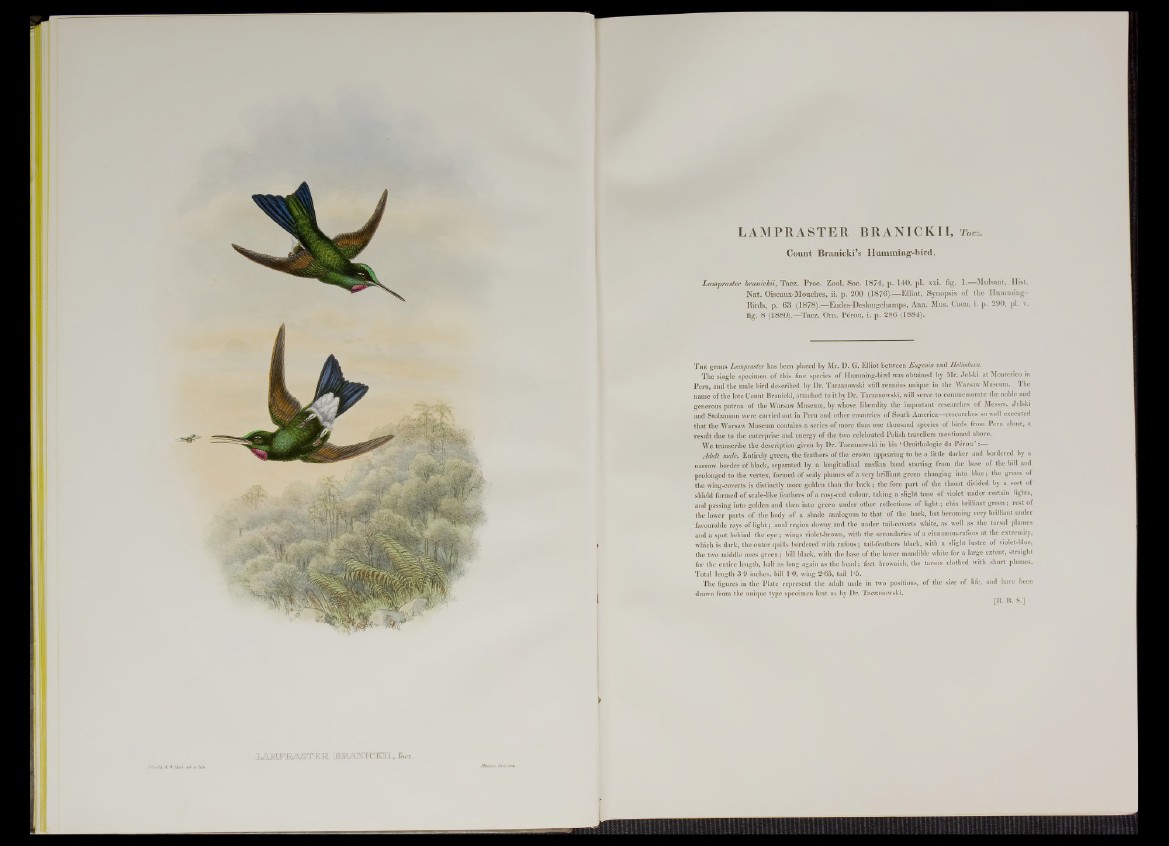
LAMPRASTER BRANICKII, Tacz.
Count Branicki’s Humming-bird.
Lampraster branichii, Tacz. Proc. Zool. Soc. 1 8 7 4 , p. 1 4 0 , pi. xxi. fig. 1.— Mulsant, Hist.
N a t. Oiseaux-Mouches, ii. p. 2 0 0 (1876).— Elliot, Synopsis o f the H umming-
Birds, p. 6 3 (1878).— Eudes-Deslongchamps, Ann. Mus. Caen, i. p. 2 9 0 , pi. v.
fig. 8 (1880).— Tacz. Orn. Pérou, i. p. 2 8 6 (1884).
The genus Lampraster has been placed by Mr. D. G. Elliot between Eugenia and Heliodoxa.
The single specimen o f this fine species of Humming-bird was obtained by Mr. Jelski at Monterico in
Peru, and the male bird described by Dr. Taczauowski still remains unique in the Warsaw Museum. The
name of the late Count Branicki, attached to it by Dr. Taczanowski, will serve to commemorate the noble and
generous patron of the Warsaw Museum, by whose liberality the important researches of Messrs. Jelski
and Stolzmann were carried out in Peru and other countries o f South America—researches so well executed
that the Warsaw Museum contains a series of more than one thousand species of birds from Peru alone, a
result due to the enterprise and energy of the two celebrated Polish travellers mentioned above.
We transcribe the description given by Dr. Taczanowski in his ‘ Ornithologie du Perou ’
Adult male. Entirely green, the feathers of the crown appearing to be a little darker and bordered by a
narrow border o f black, separated by a longitudinal median band starting from the base o f the bill and
prolonged to the vertex, formed of scaly plumes o f a very brilliant green changing into blue; the green of
the wing-coverts is distinctly more golden than the back; the fore part o f the throat divided by a sort of
shield formed o f scale-like feathers o f a rosy-red colour, taking a slight tone of violet under certain lights,
and passing into golden and then into green under other reflections of light; chin brilliant green; rest of
the lower parts of the body o f a shade analogous to that of the back, but becoming very brilliant under
favourable rays o f light; anal region downy and the under tail-coverts white, as well as the tarsal plumes
and a spot behind the eye ; wings violet-brown, with the secondaries of a cinnamon-rufous at the extremity,
which is dark, the outer quills bordered with rufous; tail-feathers black, with a slight lustre of violet-blue,
the two middle ones green; bill black, with the base of the lower mandible white for a large extent, straight
for the entire length, half as long agaiu as the head; feet brownish, the tarsus clothed with short plumes.
Total length 3*9 inches, bill 1*0, wing 2*65, tail 1*5.
The figures in the Plate represent the adult male in two positions, of the size of life, and have been
drawn from the unique type specimen lent us by Dr. Taczanowski.
[R. B. I I